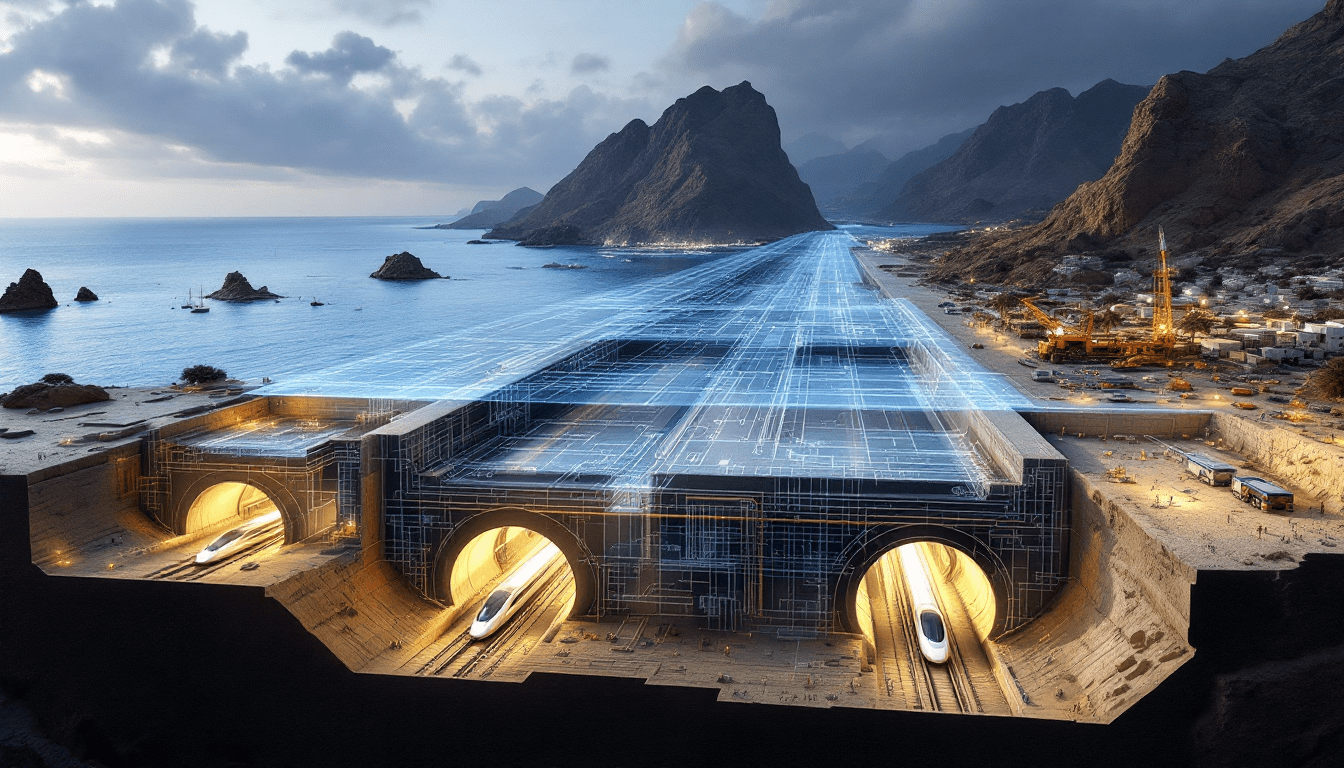Gibraltar-Tangiers Tunnel

Beneath the churning waters where the Mediterranean meets the Atlantic, where ancient Hercules supposedly split Africa from Europe with his mighty hands, modern engineers contemplate reuniting these continents through one of the most ambitious infrastructure projects ever conceived. The Gibraltar-Tangiers Tunnel represents humanity's boldest attempt to bridge continental masses since the Channel Tunnel linked Britain to France, yet this Mediterranean crossing would dwarf its northern counterpart in both technical complexity and transformative potential.
The proposed submarine railway tunnel would plunge beneath the Strait of Gibraltar, connecting Punta Paloma on Spain's southern coast with Punta Malabata near Tangier in Morocco. At its most ambitious configuration, the tunnel would stretch forty-two kilometres through the Earth's crust, with nearly thirty kilometres submerged beneath waters reaching depths of 475 metres. Unlike the relatively shallow English Channel, which required tunnellers to descend merely 75 metres below sea level, the Gibraltar crossing demands boring through geological formations at depths exceeding anything previously attempted for civilian infrastructure.
The engineering challenges transcend mere depth. The tunnel must navigate the collision zone between the African and Eurasian tectonic plates—a geologically violent frontier where continents grind against each other at five millimetres per year, generating earthquakes and deforming rock strata into tortured configurations. The Azores-Gibraltar Transform Fault, responsible for the catastrophic 1755 Lisbon earthquake which killed tens of thousands and generated tsunamis reaching fifteen metres in height, runs directly through the proposed tunnel corridor. This seismic sword of Damocles hangs over every calculation, every design decision, every boring advance.
The Physics of Intercontinental Tunnelling
The fundamental engineering approach involves constructing twin railway galleries, each measuring approximately eight metres in diameter, connected by cross-passages every 375 metres for safety and ventilation. The primary boring would follow the Camarinal Sill, a submarine ridge where water depths decrease to approximately 300 metres, substantially shallower than the 900-metre abyss found along the strait's narrowest crossing. This westward deviation, whilst adding fourteen kilometres to the tunnel's length, reduces hydrostatic pressure on the structure by two-thirds—a critical consideration when confronting water pressures exceeding thirty atmospheres.
German tunnelling technology firm Herrenknecht Iberica, renowned for constructing the Bosphorus crossing beneath Istanbul, has begun feasibility assessments employing earth pressure balance tunnel boring machines (EPB-TBMs) specifically engineered for submarine conditions. These mechanical earthworms, measuring fifteen metres in diameter and weighing over 4,000 tonnes, would advance through the seabed at approximately ten metres per day, simultaneously excavating material and installing precast concrete segments to form the tunnel lining.
The boring machines must contend with geological conditions unique to the Gibraltar region. Seabed surveys reveal alternating layers of clayey flysch—a sedimentary rock formed from ancient submarine avalanches—interspersed with calcareous deposits and zones of extremely hard crystalline rock. The flysch presents particular challenges: whilst relatively soft and easily excavated, it becomes plastic under pressure, potentially flowing like toothpaste into excavated spaces. Engineers propose injecting grout curtains ahead of the boring face, creating artificial rock through chemical solidification before excavation proceeds.
Temperature management poses another formidable challenge. Rock temperatures at proposed boring depths approach 35 degrees Celsius, whilst friction from cutting heads generates additional heat exceeding 200 degrees. Without active cooling, tunnel workers would face lethal conditions within minutes. The solution involves circulating refrigerated slurry through the cutting face whilst installing a network of cooling pipes within the tunnel lining, maintaining habitable temperatures of 25 degrees through continuous heat exchange with seawater-cooled refrigeration plants.
Conquering Seismic Demons
The tunnel's location astride the boundary between tectonic plates transforms earthquake resistance from a design consideration into an existential imperative. Spanish and Moroccan seismologists have deployed arrays of ocean-bottom seismometers—sophisticated instruments capable of detecting ground movements smaller than a human hair's width at depths exceeding 6,000 metres. These sensors reveal a complex pattern of crustal deformation, with thrust faults, strike-slip zones, and areas of active subduction creating a three-dimensional chess game of geological forces.
The engineering response involves segmented tunnel construction with flexible joints every 250 metres, allowing sections to move independently during seismic events. These expansion joints, incorporating steel bellows surrounded by compressible foam and waterproof membranes, can accommodate lateral movements up to 500 millimetres and vertical displacements of 300 millimetres—sufficient to withstand a magnitude 8.5 earthquake, the estimated strength of the 1755 Lisbon event.
Revolutionary base isolation technology, adapted from Japanese skyscraper design, would support the railway tracks on sliding bearings which decouple train movements from tunnel oscillations. During an earthquake, the tunnel might writhe like a serpent, yet trains would experience only gentle swaying, preventing derailments. Emergency refuge chambers every 1,000 metres, constructed as independent structures within enlarged tunnel sections, would provide sanctuary for passengers should seismic activity strike during transit.
Most remarkably, engineers propose incorporating a network of fibre-optic strain sensors within the tunnel lining, creating a distributed nervous system capable of detecting microscopic deformations years before they become structurally significant. This predictive maintenance approach, processing terabytes of structural health data through artificial intelligence algorithms, would identify developing problems whilst they remain manageable, preventing the catastrophic failures which have plagued other submarine tunnels.
High-Speed Rail Beneath the Sea
The operational tunnel would accommodate high-speed trains travelling at 250 kilometres per hour, reducing the Madrid-Casablanca journey to five and a half hours—transforming a two-day odyssey involving ferries and border crossings into a comfortable afternoon transit. The Spanish AVE network and Morocco's Al Boraq system, both operating on standard-gauge tracks with 25-kilovolt alternating current electrification, would merge seamlessly through the submarine link, creating an integrated transcontinental railway spanning from Edinburgh to Marrakech.
Ventilation engineering reaches extraordinary sophistication in this submarine environment. The piston effect of high-speed trains creates pressure waves exceeding 3,000 pascals, potentially rupturing eardrums if not properly managed. The solution involves pressure relief ducts every 250 metres, connected to vertical shafts rising to ventilation islands—artificial structures anchored to the seabed, breaking the surface as seemingly innocuous navigation markers whilst actually serving as the tunnel's lungs.
These ventilation islands, five in total, would measure 100 metres in diameter and rise 30 metres above sea level. Constructed from reinforced concrete caissons floated into position and sunk onto prepared seabed foundations, they would house powerful fans capable of completely refreshing tunnel air every twenty minutes. During normal operations, the train-induced airflow suffices for ventilation, but emergency scenarios—fire, chemical spills, or system failures—trigger forced ventilation modes, creating hurricane-force winds to purge contaminants.
Fire suppression pushes engineering into uncharted territory. Traditional water-based sprinkler systems risk short-circuiting the 25,000-volt overhead electrification. Instead, engineers propose a revolutionary water mist system generating droplets smaller than 100 microns—so fine they evaporate before reaching electrical equipment yet dense enough to suppress flames through oxygen displacement and cooling. Combined with pressurised escape passages maintaining higher air pressure than the main tunnels, smoke infiltration into evacuation routes becomes physically impossible.
Economic Alchemy and Continental Transformation
The tunnel's construction cost, estimated between fifteen and twenty billion euros, appears astronomical until compared with its economic impact. Trade between Europe and Africa, currently bottlenecked through congested ports and weather-dependent ferry services, would flow unimpeded through this submarine artery. Container freight, transferred from ships to rail at purpose-built terminals in Algeciras and Tangier, could reach European markets 40% faster than current maritime routes whilst generating 60% less carbon emissions.
Morocco's phosphate reserves—comprising 70% of global deposits and essential for agricultural fertilisers—would gain direct rail access to European markets, potentially reducing fertiliser costs across the continent by 15-20%. Spanish agricultural exports to Africa, currently limited by transport costs and spoilage during lengthy sea crossings, would arrive fresh in Casablanca markets within hours of harvest. The economic multiplier effects cascade through both continents: reduced transport costs lowering consumer prices, increased trade volumes generating employment, infrastructure investments spurring regional development.
Tourism implications stagger the imagination. The psychological barrier of intercontinental travel dissolves when Madrid and Marrakech become a comfortable day trip apart. Weekend breaks in Morocco for European residents, previously requiring flight bookings and airport hassles, transform into spontaneous train journeys. Moroccan workers could commute to Spanish jobs, addressing labour shortages whilst maintaining family ties. The tunnel wouldn't merely connect two continents; it would fuse their economies into an integrated Euro-African powerhouse.
Yet economic benefits extend beyond simple commerce. The tunnel would establish redundancy for global supply chains increasingly vulnerable to Suez Canal disruptions. When the Ever Given container ship blocked the Suez in 2021, global trade losses exceeded ten billion dollars daily. A high-capacity rail link between Europe and Africa creates alternative routing for Asian goods trans-shipped through North African ports, providing supply chain resilience worth hundreds of billions annually.
Environmental Reckoning
The environmental implications present both promise and peril. Construction would generate approximately 50 million tonnes of excavated material—enough to build an artificial island the size of Gibraltar itself. Engineers propose using this material for land reclamation projects, creating new ports and industrial zones whilst avoiding the environmental catastrophe of ocean dumping. The boring process itself, whilst energy-intensive, would employ electric machinery powered by renewable sources, with Spain's extensive solar farms and Morocco's wind installations providing carbon-neutral construction energy.
Marine ecosystem disruption during construction appears unavoidable. The strait serves as the sole connection between the Atlantic and Mediterranean, with powerful currents exchanging 1.5 million cubic metres of water per second. Construction activities—seafloor drilling, sediment disturbance, noise pollution—would affect cetacean migration routes, with fin whales, sperm whales, and several dolphin species traversing these waters. Mitigation proposals include seasonal construction pauses during peak migration periods and bubble curtains to dampen underwater noise, though environmental groups remain sceptical about protecting these crucial marine highways.
Once operational, however, the tunnel's environmental benefits multiply. Each freight train replacing forty lorries eliminates 1,000 kilometres of road transport emissions. Passenger trains, powered by renewable electricity, generate 90% less carbon per passenger-kilometre than flights. The modal shift from air and road to rail could reduce transport emissions between Europe and Africa by 30 million tonnes annually—equivalent to removing six million cars from roads permanently.
Engineering the Impossible
The construction methodology pushes human engineering capabilities towards their absolute limits. Initial phases involve creating artificial islands at both tunnel portals, providing staging areas for the massive infrastructure required. These islands, constructed from caissons filled with rock and concrete, would measure 500 metres square and rise 10 metres above high tide, housing everything from worker accommodation to concrete manufacturing plants.
The actual boring proceeds from four faces simultaneously—two from each portal and two from a temporary access shaft constructed on one of the ventilation islands. This approach reduces construction time from thirty years to fifteen, though coordinating four independent boring operations through uncertain geology whilst maintaining millimetre precision presents logistical challenges comparable to synchronising a lunar mission.
Surveying accuracy becomes paramount when boring teams must meet precisely after advancing twenty kilometres through solid rock. Engineers employ gyroscopic guidance systems, originally developed for intercontinental ballistic missiles, maintaining heading accuracy within 0.001 degrees. Laser ranging systems, bouncing light pulses off retroreflectors installed in the tunnel lining, detect deviations exceeding five millimetres, allowing continuous course corrections.
Worker safety in this hostile environment demands extraordinary measures. Every tunnel worker would wear biosensors monitoring heart rate, body temperature, and blood oxygen levels, with artificial intelligence algorithms predicting heat exhaustion or decompression sickness hours before symptoms appear. Hyperbaric rescue chambers, stationed every 500 metres, could accommodate twenty workers for 72 hours, providing life support whilst rescue teams navigate potentially flooded or collapsed tunnel sections.
Geopolitical Bridges and Cultural Fusion
Beyond physical infrastructure, the tunnel represents a geopolitical statement of unprecedented boldness. Two civilisations, separated since the Zanclean flood refilled the Mediterranean basin 5.3 million years ago, would reunite through human ingenuity. The symbolism resonates particularly given historical tensions: Spain and Morocco have disputed territories, fishing rights, and migration policies for decades. Yet both nations recognise the tunnel's potential to transform confrontation into cooperation.
The 2030 FIFA World Cup, jointly hosted by Spain, Portugal, and Morocco, provides a compelling deadline for tunnel completion, though engineers privately acknowledge this target as aspirational rather than achievable. The tournament offers perfect symbolism—football uniting continents as the tunnel would unite their transport networks. Spanish and Moroccan leaders speak of the "intercontinental metro," envisioning commuters reading newspapers as their train glides between continents as routinely as Londoners traverse the Thames.
Cultural exchange would intensify exponentially. Moroccan students could attend Spanish universities whilst living at home. Spanish companies could access African markets through Moroccan partnerships solidified by proximity. The artificial barrier of the strait, which has shaped Mediterranean civilisation since antiquity, would evaporate in a mere half-hour train ride.
Security considerations, whilst substantial, appear manageable through technology. Biometric scanning, chemical detection, and artificial intelligence surveillance would monitor every passenger and freight consignment. The tunnel's isolation—accessible only through controlled portals—actually simplifies security compared to porous land borders. International cooperation agreements, similar to Channel Tunnel protocols, would establish joint security forces and shared intelligence systems.
The Future Descending
As Herrenknecht's engineers finalise their feasibility studies and seismometers probe the strait's hidden depths, the Gibraltar-Tangiers Tunnel transitions from fantasy to possibility. The technology exists—tunnel boring machines have conquered similar depths, though never at this scale. The economics align—trade volumes and passenger demand justify the investment, though financial engineering matching the tunnel's ambition remains incomplete. The politics converge—both nations recognise mutual benefits outweighing historical grievances.
Yet uncertainty permeates every aspect. Will climate change and rising sea levels compromise ventilation islands? Can boring machines penetrate rock formations still hiding geological surprises? Will public support sustain a fifteen-year construction project inevitably plagued by delays and cost overruns? These questions lack definitive answers, yet humanity's greatest achievements have always required leaping into uncertainty.
The Gibraltar-Tangiers Tunnel embodies humanity's refusal to accept natural barriers as permanent limitations. Just as our ancestors bridged rivers, crossed mountains, and eventually flew between continents, we now contemplate threading railways through the Earth's crust beneath kilometres of seawater. The engineering appears impossibly complex, the risks unconscionably high, the costs astronomically vast—yet these same objections greeted every transformative infrastructure project from Roman aqueducts to the Panama Canal.
Should this submarine railway become reality, future generations might regard the Mediterranean's division as a quaint historical curiosity, like medieval maps warning of sea monsters. Children born after 2040 might consider separate European and African transport networks as archaic as steam engines—relics from an era when humanity lacked the audacity to tunnel between continents. The impossible, through engineering brilliance and political will, edges towards inevitability, one boring metre at a time.



